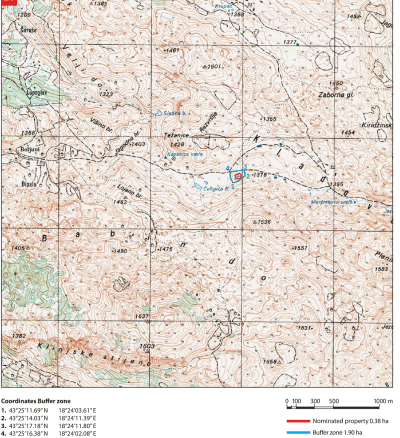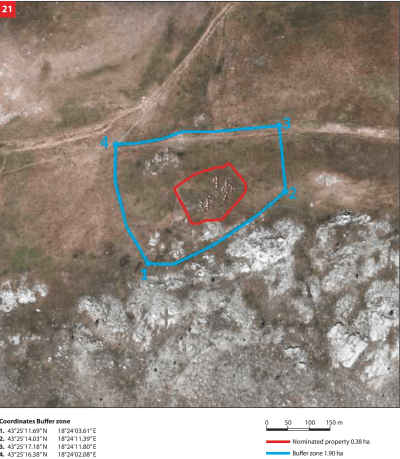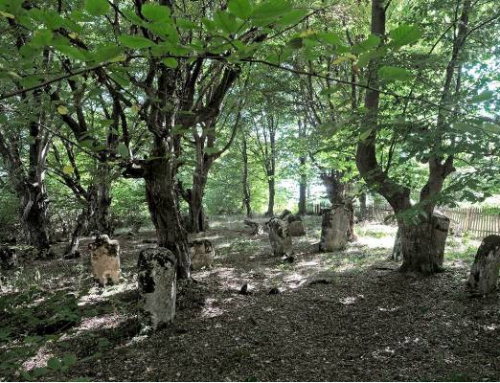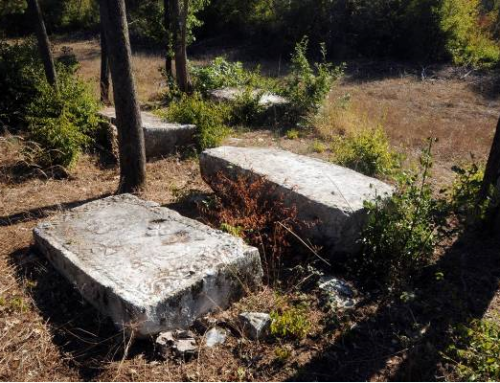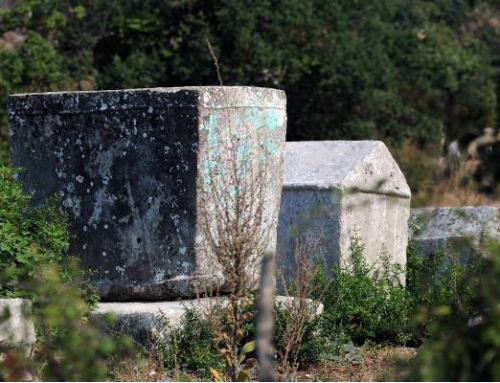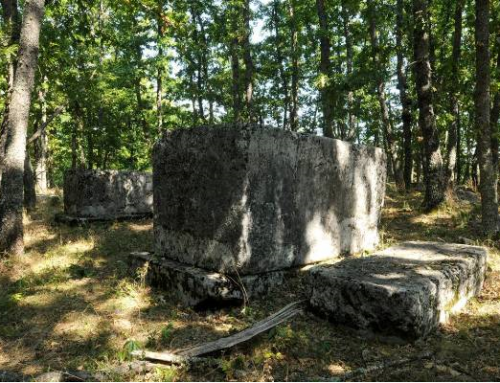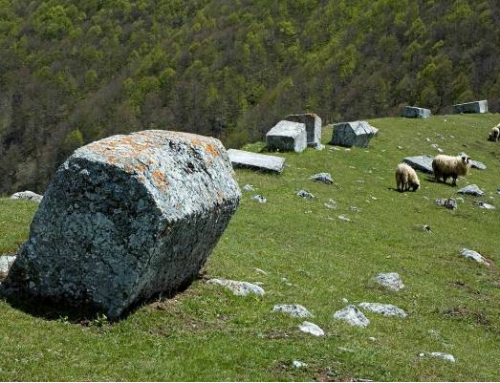About

The necropolis Čengića Bara is located on a gentle hill in the middle of the karst valley at an altitude of 1370 meters above sea level. It is situated about 11 km to the south-west of Kalinovik. The tombstones are west-east oriented and laid in rows. Monuments are well-carved and preserved, cut of limestone. The quarry is located around 100 meters south-east to the necropolis.
According to the data available to the Commission to Preserve National Monuments, 52 tombstones were found at the locality: 11 slabs, 35 chests, including a significant number of high chests with bases and 6 gabled roof tombstones. According to the data obtained following research carried out by the Institute for Protection of Cultural, Historical and Natural Heritage of Republika Srpska /Republički zavod za zaštitu kulturno istorijskog i prirodnog naslijeđa RS/ in 2012, a total of 54 tombstones were recorded, of which 22 chests, 7 chests with bases, 22 slabs and 2 gabled roof tombstones with bases.
Out of 19 decorated tombstones, 1 is a slab, 12 are chests and 6 are gabled roof tombstones. The most represented motifs are twisted bands and friezes with winding trefoils, followed by motifs of shield and sword, vegetal stylizations, cross in circular wreaths, birds, deer and deer hunting scenes, wheel dance (kolo) and tournaments.
One tombstone bears an inscription stating that Stojan Opodinović lies buried there.
The surroundings of Kalinovik and Kalinovik villages have not been sufficiently archaeologically explored. Yet numerous remains of fortifications and settlements in the areas of Kalinovik, Boženova glava, Jasen, Vrhovina, Hotovlje, Kutine, Dobro Polje, Koriljevo, Gradac, Jelašca, Šivolji, Jažići, Vlaholje and Gvozno, indicate that the area had been inhabited even in prehistoric times. Gradac in Gvozno is a prehistoric fort where, by method of archaeological field survey in 1953, archaeological material from the Bronze and Iron Ages was found. The sites from antiquity were found in several places, especially the remains of a road network connecting Bosnian trading and mining settlements with Hum, Dubrovnik and the coast. The remains of Roman roads are visible in the villages of Jažići, Mosorovići and Bukvica. Those routes were guarded by military camps and there is no other evidence of a developed economy there. It is assumed that a small number of inhabitants lived from cattle breeding. Since ancient times, the farmers, who would come from the lowland of Herzegovina, visited the south-western part of the mountain. In addition to livestock, the inhabitants of Gvozno also engaged in mountain farming. In the Middle Ages, the area became largely populated, and the main occupations were trade and cattle breeding. As the centre of the Zagorje County, the medieval village of Kučevo was first mentioned in 1180. In the Middle Ages, Zagorje stretched from Dobro Polje (Good field) to the upper Neretva River and the old Viševa County with the city of Veletín. The county belonged to Bosnia, which is confirmed by the existence of a customs office of Duke Sandalj Hranić Kosača in 1406. In the charters of Aragon and Naples King Alfonso V from 1444 and 1445, Valentin and Obalj were mentioned as fortified towns in Zagorje. In the Kalinovik area, there are remains of other two fortified towns, near the villages of Ljušići and Bojići.
A dynamic life during the Middle Ages is evidenced by a number of necropolises with many decorated tombstones, some of them with inscriptions. Their number and type have been noted in research studies, but archaeological investigations have not been carried out.
From 1954 to 1956, within the programme of the National Institute for Protection of Cultural Monuments of People’s Republic of Bosnia and Herzegovina, the information about the necropolises with tombstones around Kalinovik were noted and processed. The necropolises have not been subject to archaeological survey.
Location
The necropolis with tombstones is in the vicinity of Čengića Bara, a cattle breeding summer settlement located in the high karst field called Kladovo polje, on Zelengora Mountain. The northern boundary of the necropolis is defined by a local macadam road.
State of the location
The natural environment of the necropolis is outstanding and we can say that it is in good state, although a substantial number of the tombstones have been damaged due to long-term impact of environmental factors. The tombstones are severely affected by the presence of plant organisms, lichen and moss. Many of the tombstones are sunken, which is why they cannot be examined in their entirety. To determine the final number of decorated tombstones, the necropolis needs to be cleaned, which primarily implies removal of moss and research work that would provide final data about representation and diversity of decorative motifs
In 2011 the entire site underwent geodetic survey supported with photographs of individual tombstones thus enabling for implementation of a monitoring process.
FAQ
The necropolis with the tombstones is located outside the populated area. The access road is unpaved. The necropolis is marked by basic tourist signs. Statistical data on the number of visitors are not available. The necropolis is located within the Sutjeska National Park. Municipal tourist resources are related to natural heritage – the mountains Zelengora and Treskavica, the upper course of the Neretva River, religious facilities, archaeological sites and ancient towns. There is a Tourist organisation operating in the Municipality.
